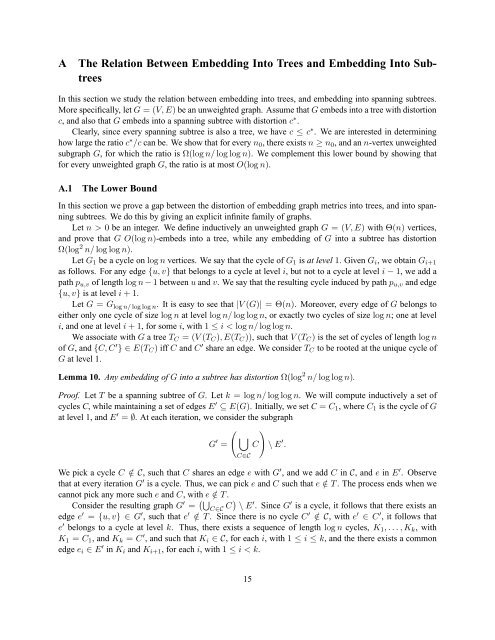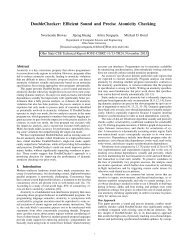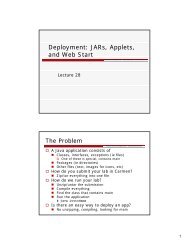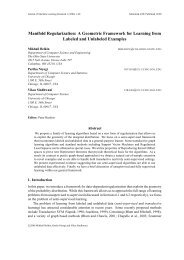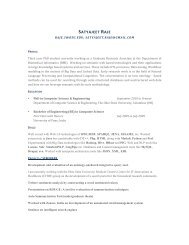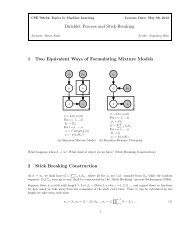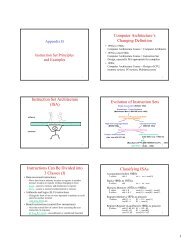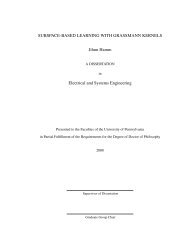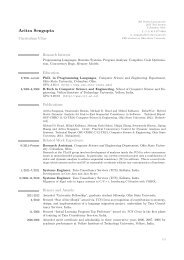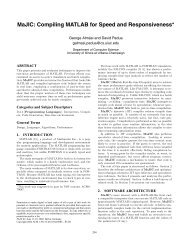Approximation Algorithms for Embedding General Metrics Into Trees
Approximation Algorithms for Embedding General Metrics Into Trees
Approximation Algorithms for Embedding General Metrics Into Trees
Create successful ePaper yourself
Turn your PDF publications into a flip-book with our unique Google optimized e-Paper software.
A<br />
The Relation Between <strong>Embedding</strong> <strong>Into</strong> <strong>Trees</strong> and <strong>Embedding</strong> <strong>Into</strong> Subtrees<br />
In this section we study the relation between embedding into trees, and embedding into spanning subtrees.<br />
More specifically, let G = (V,E) be an unweighted graph. Assume that G embeds into a tree with distortion<br />
c, and also that G embeds into a spanning subtree with distortion c ∗ .<br />
Clearly, since every spanning subtree is also a tree, we have c ≤ c ∗ . We are interested in determining<br />
how large the ratio c ∗ /c can be. We show that <strong>for</strong> every n 0 , there exists n ≥ n 0 , and an n-vertex unweighted<br />
subgraph G, <strong>for</strong> which the ratio is Ω(log n/log log n). We complement this lower bound by showing that<br />
<strong>for</strong> every unweighted graph G, the ratio is at most O(log n).<br />
A.1 The Lower Bound<br />
In this section we prove a gap between the distortion of embedding graph metrics into trees, and into spanning<br />
subtrees. We do this by giving an explicit infinite family of graphs.<br />
Let n > 0 be an integer. We define inductively an unweighted graph G = (V,E) with Θ(n) vertices,<br />
and prove that G O(log n)-embeds into a tree, while any embedding of G into a subtree has distortion<br />
Ω(log 2 n/log log n).<br />
Let G 1 be a cycle on log n vertices. We say that the cycle of G 1 is at level 1. Given G i , we obtain G i+1<br />
as follows. For any edge {u,v} that belongs to a cycle at level i, but not to a cycle at level i − 1, we add a<br />
path p u,v of length log n −1 between u and v. We say that the resulting cycle induced by path p u,v and edge<br />
{u,v} is at level i + 1.<br />
Let G = G log n/log log n . It is easy to see that |V (G)| = Θ(n). Moreover, every edge of G belongs to<br />
either only one cycle of size log n at level log n/log log n, or exactly two cycles of size log n; one at level<br />
i, and one at level i + 1, <strong>for</strong> some i, with 1 ≤ i < log n/log log n.<br />
We associate with G a tree T C = (V (T C ),E(T C )), such that V (T C ) is the set of cycles of length log n<br />
of G, and {C,C ′ } ∈ E(T C ) iff C and C ′ share an edge. We consider T C to be rooted at the unique cycle of<br />
G at level 1.<br />
Lemma 10. Any embedding of G into a subtree has distortion Ω(log 2 n/log log n).<br />
Proof. Let T be a spanning subtree of G. Let k = log n/log log n. We will compute inductively a set of<br />
cycles C, while maintaining a set of edges E ′ ⊆ E(G). Initially, we set C = C 1 , where C 1 is the cycle of G<br />
at level 1, and E ′ = ∅. At each iteration, we consider the subgraph<br />
( ) ⋃<br />
G ′ = C \ E ′ .<br />
C∈C<br />
We pick a cycle C /∈ C, such that C shares an edge e with G ′ , and we add C in C, and e in E ′ . Observe<br />
that at every iteration G ′ is a cycle. Thus, we can pick e and C such that e /∈ T . The process ends when we<br />
cannot pick any more such e and C, with e /∈ T .<br />
Consider the resulting graph G ′ = (⋃ C∈C C) \ E ′ . Since G ′ is a cycle, it follows that there exists an<br />
edge e ′ = {u,v} ∈ G ′ , such that e ′ /∈ T . Since there is no cycle C ′ /∈ C, with e ′ ∈ C ′ , it follows that<br />
e ′ belongs to a cycle at level k. Thus, there exists a sequence of length log n cycles, K 1 ,... ,K k , with<br />
K 1 = C 1 , and K k = C ′ , and such that K i ∈ C, <strong>for</strong> each i, with 1 ≤ i ≤ k, and the there exists a common<br />
edge e i ∈ E ′ in K i and K i+1 , <strong>for</strong> each i, with 1 ≤ i < k.<br />
15


